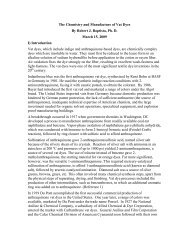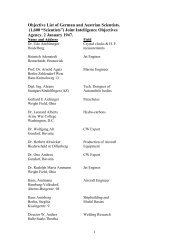International Dyestuff Industry - ColorantsHistory.Org
International Dyestuff Industry - ColorantsHistory.Org
International Dyestuff Industry - ColorantsHistory.Org
You also want an ePaper? Increase the reach of your titles
YUMPU automatically turns print PDFs into web optimized ePapers that Google loves.
Figure 7. Final Form of Perkin's Alizarin Plant. Edelstein<br />
Collection, Hebrew University.<br />
When Perkin described the boiler to Caro early in May 1870, it was already assembled and<br />
awaiting the arrival of a valve, prior to trials. Caro was then experimenting with a steam<br />
treatment, presumably also in a pressurized vessel on a pilot scale. Subsequently, Perkin<br />
had a pressure tube made up for Caro, who appeared to have had less success with this<br />
equipment.<br />
Initially, the caustic soda was added. This was of “70 per cent quality, dissolved; 700 lbs.<br />
weight was usually employed. 1,300 Lbs. of a concentrated solution of the soda salt was<br />
then added, and well mixed.“ [32] The mixture was contained in the iron pan fitted with a<br />
steam jacket shown at b. The valves were adjusted to permit the mixture to run into the<br />
pressure tubes by gravitation along pipe e. The valves were then closed and the chamber<br />
was heated to 180° C for one day. Portions were removed occasionally so that the progress<br />
of the reaction could be monitored. On cooling, the valves in the pipe f were carefully<br />
opened and the contents of the pressure tubes were forced to the top of the building into<br />
the tanks g, fitted with funnels to allow escape of steam through the roof.<br />
The alkaline purple fluid was then slowly run into wooden precipitating tanks, h, containing<br />
dilute sulfuric acid. The color of the solution turned orange as the sodium was displaced<br />
from the salt to release the required hydroxyanthraquinones. Following overnight cooling,<br />
the supernatant liquid was run into the ground floor tanks j, and then water was poured<br />
onto the precipitate and the mixture was transferred to the “color filters” k, situated on the<br />
first floor, and fitted out in a manner similar to the filters used to separate the lime salts.<br />
The first drainings were collected into tanks on the ground floor from which any solid was<br />
occasionally collected.<br />
The solid product from the filters was washed several times to remove salt, and until<br />
neutral to litmus paper. Dried material was delivered by the truck l to the stock tub m. The<br />
truck was weighed before and after each filling, so that the amount of dye (invariably of no<br />
more than ten percent purity) in the tub could be calculated. Finally, the coloring matter<br />
was thoroughly mixed to make homogenous. A sample was taken for analysis, and when





